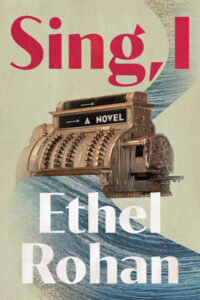I can’t write crime. That’s the troubling discovery I made while drafting my second novel Sing, I. As a disciple of the crime genre for decades, particularly detective fiction and more recently true crime, I initially found my inability to write crime deeply frustrating and surprising. I knew from the outset that Sing, I would begin with a store holdup and the robber would continue to commit local crimes and evade capture. As I wrote on, I fully expected Ester, my main character and one of two victims of the store holdup, to become increasingly embroiled in the hunt for the repeat offender—along the lines of a heart-trembling psychological thriller. But Sing, I’s story and characters refused to bend to my will and instead insisted on veering full-throttle to the domestic.
This is where I risk admitting to the uncanny sense that I’m not always in charge when writing. It’s like I’m sometimes the sock and storytelling is the moving hand. A more grounded interpretation is that when I stop forcing, the best story flows. Thus, through an ultimately copacetic weaving of my and my characters’ choices, Sing, I defied the crime genre and remained within my wheelhouse of family-centered fiction. And as it turned out, surrendering my hopes of writing a great crime novel wasn’t Sing, I’s most painstaking demand on me. While writing always comes with challenges, and too often the practice can be a sadistic master, that end point of a finished, organic manuscript came at a price I never anticipated. Sing, I plunged me into a reckoning with my long-held devotion to the crime genre and forced me to face how trauma, my own and others, complicates that affinity.
We writers inflict suffering. It’s how we test and reveal and change our characters. There’s no story without torment. Before Sing, I, I felt little to no hesitancy in putting my characters through mounting obstacles and pain. It’s what this job requires and I undertook the task with the necessary care and unflinching aplomb. But Sing, I as a would-be crime novel required me to go further than ever before in how I beset my characters and I found that there were punitive places I could not enter. As the characters in Sing, I built from splinters to fully-formed, from idea to real, the more I resisted subjecting them to the typical tropes of the crime genre. In particular, I found myself balking at depicting violence, especially against my women characters, and at giving their assailant a voice. So much so, I started questioning my entire longtime appetite for crime books, podcasts, and TV and film. All of which overwhelmingly center offenses against girls and women that are sexual, gruesome, and fatal in nature. Misogynistic, heinous crimes that mirror those inflicted in real life, daily, globally, relentlessly. Did I really want to add to a canon that portrays that horrific reality? In wrestling with that, I returned in time.
I first tuned in to crime as a teen, addicted to the lighter fare offered by the ilk of Agatha Christie and Arthur Conan Doyle. I couldn’t get enough of their gripping plots and brilliant sleuthing, the mystery and suspense. I loved trying to figure out whodunit before it was revealed on the page or screen and delighted when my best guesses were almost always foiled. It was wonderfully reassuring that the novels’ shrewd detectives would unfailingly solve the complex case. Somewhat unconsciously at the time, I liked that these suspenseful mysteries were never of a sexual nature and weren’t always murders. When they were homicides, the men and women victims were glimpsed as mere corpses and rarely if ever fully realized characters. That meant I didn’t need to feel anything for the deceased, they were more prop than real, and instead I could immerse myself in the wholly satisfying task of unravelling clues, eliminating suspects, catching the killer, and seeing justice served. In this way, crime fiction delivered what my own life hadn’t. The adult family friend who had sexually abused me from age 5 to 13 got away with his crimes and would never stand accused and convicted.
As a young adult, my crime reading and watching tastes graduated to such favorites as Patricia Highsmith, Ken Follett, and P.D. James. I later went through a James Patterson phase and The Firm was my gateway to John Grisham. The early 2000s brought me to grisly offerings from Dan Brown and Dennis Lehane that didn’t hold back on our potential for depravity, particularly men’s. Later in the decade, Stieg Larsson’s books were among the more memorable fixes for my thriller habit. In most of the crime I read and watched as an adult, I was increasingly struck by how far the pendulum had swung toward the violent and graphic—storylines rife with sensationalized plots, grotesque crimes, romanticized psychopaths, and objectified women victims. This sharply shifted my teen perspective on corpses as props. Where once this ploy served to showcase the story’s whodunit elements and minimize triggering readers and viewers, the modern motif of women’s often desecrated dead bodies as set design reflects an atrocious reality: Women are considered less than and too often are deemed dispensable if not outright culpable in their brutal ends. But while I became more selective and less tolerant in the crime I consumed, I remained an avid fan.
I felt sure I would take these sensibilities into the crafting of Sing, I and deliver a crime novel that contained the best of the genre and refused to delve into the gratuitous, exploitative, and dehumanizing. Further, I was fat on endless inspiration thanks to the ongoing burgeoning growth of women crime writers and felt eager to add my silenced voice to theirs—full of a sense of kinship with women bursting with provocative stories to tell and seizing their time. I wanted to be among the ranks of those crime writers who wield their power to reclaim and reframe women’s experiences on their own terms. These authors are taking back control and turning the abhorrent into art, into meaning, into condemnation, into a revolution. No longer will girls and women allow ourselves to be gaslit, trivialized, appropriated, and dismissed. No longer will we minimize our experiences and trauma for the comfort and convenience of others, least of all our tormentors and patriarchy as a whole. But despite my trying to avail myself of this higher calling in the early drafts of Sing, I, I continued to fail in my efforts to write crime.
Somewhere in this angst, I confronted the obvious if difficult. Perhaps my being a victim of childhood abuse and partner abuse in young adulthood prevented me from engaging with the crime genre as a writer. Like maybe I could consume it but I couldn’t go in-depth and create it. Cue my delve into considerations of control. In no news to anyone, trauma victims find comfort in structure and wrangling chaos into order. So, I already knew that part of the crime genre’s hold over me was in how it placed me in a controlled environment. There, I could allow unwanted feelings like fear and shame and ickiness to resurface in an interaction where I was essentially safe and could pull myself out of at any time. More often than not, I find these situations less triggering and more recalibrating. Each time I reexperienced the unwanted awfulness that certain scenes on the page and screen evoked, my inner disturbances invariably lessened rather than ratcheted. This, alongside the satisfying sense of a case solved and justice served that I touched on above, largely soothed me. There’s also something ironically reassuring and sanity-saving in seeing the terribleness of the world reflected back to us through pop culture when too many power systems for their own gains seek to deny women the validity of what we see, hear, feel, think, and experience. Given all this, I concluded that my PTSD hadn’t hindered my ability to write crime. When I returned to the spark that started Sing, I, I hit on exactly what had—beyond, that is, my willful characters.
When I was ten years old, I was the first to arrive at the scene of a store holdup right as three thieves exited, guffawing and hauling large black plastic bags lumpy with cartons of cigarettes and bottles of alcohol. The injured salesclerk remained behind the wooden counter, looking as violated and asunder as the plundered shelves and littered, liquored floor. His assailants had stabbed him in the head with a broken bottle and he stood struggling for breath, his face a thick half-mask of blood. His lone clear eye, it was a light gone out. To this day, that holdup haunts me. I fully intended to at least put it to good use in Sing, I as a crime novel. That’s where Sing, I, like the fictional detectives I favor, turned out to be way smarter than me. Sing, I wound up focusing on the traumatic impact and ripple effects of crimes that are all-too-often considered minor. It became a raison d’etre to center victims and show the devastation caused to them by supposedly lesser crimes and trespasses. In a world where people have become ever more desensitized and uncaring, Sing, I testifies to how traumatic ostensibly insignificant crimes can be. I worry about and am frightened by people’s increasing inhumanity and that’s where I perhaps most see my guiding hand in Sing, I. The novel is an appeal to our dwindling empathy levels and growing lack of sympathy for human suffering. Just as several of Sing, I’s characters find their way to embracing their true selves, I’ve come to celebrate the fact that Sing, I is not a crime novel as I’d first hoped. It is its own story entirely.
***





















